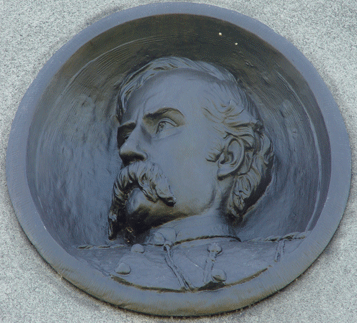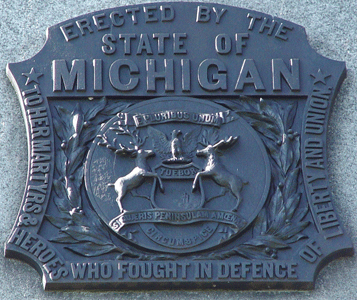Union monuments at Gettysburg > Michigan
1st, 5th, 6th & 7th Michigan Cavalry Regiments
The monument to the Michigan Cavalry Brigade is east of Gettysburg on East Cavalry Battlefield. (East Cavalry Battlefield – south tour map)

Monument to the Michigan Cavalry Brigade at Gettysburg
About the monument to the Michigan Cavalry Brigade
The granite monument stands over thirty feet tall and features a statue of a cavalryman on a base supported with pillars topped with horse-head capitols. Midway up the front of the monument is a circular bronze relief of General Custer, and on the side is a brass tablet with the Seal of the State of Michigan. On the front of the base is a bronze bas-relief of the brigade’s charge on July 3, with inscriptions on the other three sides. The monument was dedicated by the State of Michigan on June 12, 1889.
The Michigan Cavalry Brigade at Gettysburg
It was unusual in the Union army for all the regiments in a brigade to be from the same state, but the Wolverine Brigade was one of the exceptions. Three days before the fighting started at Gettysburg they were assigned a new commander, promoted from Captain to Brigadier General in one step and the youngest general in the army, George Armstrong Custer.
Custer’s brigade clashed with Stuarts Confederate cavalry at the Battle of Hanover, Pennsylvania on May 30 and on July 2 at the Battle of Hunterstown a few miles north of Gettysburg. On July 3rd Custer and his Wolverines played a major role in defeating Confederate General Jeb Stuart’s attempted cavalry thrust around the Union army’s right flank. They would go on to be one of the elite units in the Union army.
Text and images from the front (Northwest face) of the monument:
Michigan Cavalry Brig.
2nd Brig. 3rd Div. Cavalry Corps

Bas-relief of Brigadier General George A. Custer from the front of the monument

Bronze tablet from the monument
Text and images from the left (Northeast face) of the monument:

This monument marks the field where the Michigan Cavalry Brigade under its gallant leader General George A. Custer rendered signal and distinguished service in assisting to defeat the further advance of a numerically superior force under the Confederate General J. E. B. Stuart which in conjunction with Pickett’s Charge upon the centre, attempted to turn the right flank of the Union Army at that critical hour of conflict upon the afternoon of July 3rd, 1863.
Field held from 9 a.m. until 7 p.m.
1st Mich.; killed 10 men, wounded 6 officers 37 men, missing 20 men.
5th Mich.; killed 1 officer 7 men, wounded 1 officer 29 men, missing 18 men.
6th Mich.; killed 1 man, wounded 2 officers 24 men, missing 1 man.
7th Mich.; killed 13 men, wounded 4 officers 44 men, missing 39 men.
Total casualties 257.
Text and images from the rear (Southeast face) of the monument:
1st Michigan Cavalry Regiment Mustered in at Detroit, Mich. Sep 13, 1861. Mustered out at Salt Lake City, Utah, Mar. 10, 1866. Total enrollment 3244 officers and men. Killed 10 officers 92 men. Died of wounds 5 officers 46 men. Died of disease 5 officers 246 men. Total casualties 404. Participated in 67 skirmishes and general engagements from Winchester, Va., Mar. 23, 1862 to Appomattox Va. April 9, 1865.
Fifth Michigan Cavalry Regiment Mustered in at Detroit, Mich, August 30, 1862. Mustered out at Fort Leavenworth, Kas. June 2nd, 1865. Total enrollment 1198 officers and men. Killed, 4 officers 94 men. Died of Wounds 1 officer 23 men. Died of disease, 3 officers 233 men. Total casualties 358. Participated in 56 skirmishes and general engagements from Hanover, Pa. June 30, 1863 to Appomattox, Va., April 9, 1865.
Text and images from the right (Southwest face) of the monument:
Sixth Michigan Cavalry Regiment Mustered in at Grand Rapids, Mich. Oct. 13, 1862, Mustered out at Fort Leavenworth, Kas. Nov. 24, 1865. Total enrollment 1624 Officers and men. Killed, 7 officers 35 men. Died of Wounds 18 men. Died of disease, 266 men. Total casualties 386. Participated in 56 skirmishes and general engagements from Hanover, Pa. June 30, 1863 to Appomattox, Va., April 9, 1865.
Seventh Michigan Cavalry Regiment Mustered in at Grand Rapids, Mich. Jan. 16, 1863. Mustered out at Fort Leavenworth, Kas. Dec. 16, 1865. Total enrollment 1779 officers and men. Killed 2 officers 47 men. Died of wounds 2 officers 24 men. Died of disease 1 officer 246 men. Total casualties 322. Participated in 56 skirmishes and general engagements from Hanover, Pa. June 30, 1863 to Appomattox, Va., April 9, 1865.
Erected by the State of Michigan
to honor her martyrs & heros
who fought in defence of liberty and union.
About the regiments of the Wolverine Brigade
1st Michigan Cavalry
Commanded at Gettysburg by Colonel Charles H. Town. It brought 502 men to the field. See more about the history of the 1st Michigan Cavalry.
5th Michigan Cavalry
Commanded at Gettysburg by Colonel Russel A. Alger. It brought 770 men to the field. See more about the history of the 5th Michigan Cavalry.
6th Michigan Cavalry
Commanded at Gettysburg by Colonel George Grey. It brought 611 men to the field. See more on the history of the 6th Michigan Cavalry.
7th Michigan Cavalry
Commanded at Gettysburg by Colonel William D’Anton Mann. It brought 461 men to the field. See more on the history of the 7th Michigan Cavalry.
Location of the monument
The monument to the Michigan Cavalry Brigade is three miles east of Gettysburg on the East Cavalry Battlefield, about 180 feet south of Cavalry Field Road and 0.3 mile west of Low Dutch Road. (39°49’34.3″N 77°09’55.2″W)
